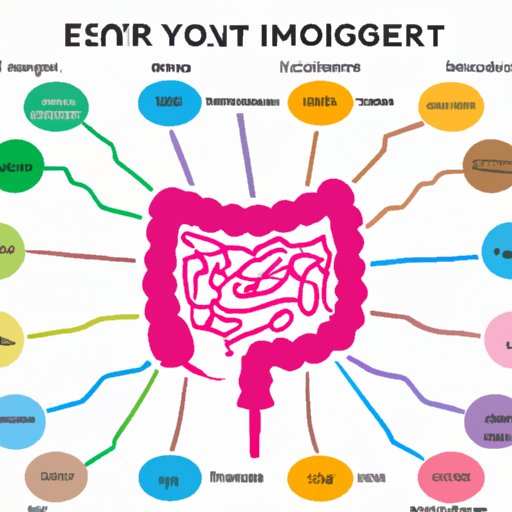Introduction
The digestive system is an important part of our bodies that helps us break down food into nutrients that can be used by our cells. This process begins in the mouth, where food is chewed and mixed with saliva, and then moves through the esophagus, stomach, small intestine, and large intestine before being eliminated from the body. But how does food travel through this complex system? In this article, we’ll explore the role of enzymes, bacteria, hormones, and fiber in helping food travel through the digestive system.

The Role of Enzymes in Breaking Down Food
Enzymes are proteins produced by cells that help to break down complex molecules into simpler ones. In the digestive system, enzymes help to break down food into smaller particles that can be more easily absorbed into the bloodstream. For example, amylase is an enzyme found in saliva that breaks down carbohydrates into sugars, while proteases are enzymes that break down proteins into amino acids.
In addition to helping to break down food, enzymes also play an important role in digestion by activating hormones that control the absorption of nutrients. For example, cholecystokinin (CCK) is a hormone that is released when certain enzymes are present in the small intestine, which signals the gallbladder to release bile to help digest fats.

Exploring the Different Parts of the Digestive System
Now that we’ve explored the role of enzymes in breaking down food, let’s take a look at the different parts of the digestive system and how food travels through each one.
Mouth and teeth: The first step in digestion is chewing. Chewing breaks down food into smaller particles, which increases the surface area for enzymes in saliva to work on. Additionally, the teeth help to grind food into even smaller pieces.
Esophagus: Once food has been chewed and swallowed, it enters the esophagus. The esophagus is a tube that connects the mouth to the stomach, and it uses muscular contractions called peristalsis to push food through its length.
Stomach: The stomach is a sac-like organ that stores and digests food. It produces gastric juices that contain enzymes and hydrochloric acid, which help to break down food further. The stomach also churns food and mixes it with these digestive juices to form a thick liquid called chyme.
Small intestine: After leaving the stomach, food enters the small intestine, which is the longest part of the digestive tract. Here, enzymes from the pancreas and bile from the liver break down food further, and the walls of the small intestine absorb the nutrients into the bloodstream.
Large intestine: The large intestine is the final part of the digestive system. Its main function is to absorb water and electrolytes from food that has not been digested, as well as to eliminate waste products from the body.
Understanding the Role of Bacteria in Digestion
Bacteria are single-celled organisms that live in the human gut. They play an important role in digestion by breaking down complex molecules that would otherwise be indigestible. For example, some bacteria produce enzymes that break down dietary fiber into short-chain fatty acids, which can be used by the body for energy.
In addition to aiding in the digestion of food, bacteria also have several other benefits. They can help prevent the growth of harmful bacteria in the gut, synthesize vitamins, and stimulate the immune system. Therefore, having a healthy balance of bacteria in the digestive system is essential for optimal health.

Exploring the Role of Hormones in Digestive Processes
Hormones are chemicals released by endocrine glands that help regulate various bodily functions. In the digestive system, hormones play an important role in controlling the movement of food through the digestive tract and the absorption of nutrients. Some common hormones involved in digestion include gastrin, secretin, and cholecystokinin (CCK).
Gastrin is a hormone that stimulates the production of stomach acid, which helps to break down food. Secretin is a hormone that stimulates the release of pancreatic juice, which is rich in enzymes that break down carbohydrates, proteins, and fats. Finally, CCK is a hormone that triggers the release of bile from the gallbladder, which helps to break down fats.
The Benefits of Eating Fiber-Rich Foods for Digestion
Fiber is an indigestible plant-based carbohydrate that passes through the digestive system undigested. It is found mainly in fruits, vegetables, legumes, and whole grains. Eating a diet rich in fiber can help with digestion in several ways.
First, fiber adds bulk to stool, which helps to promote regular bowel movements. Additionally, fiber can help to slow down digestion, which allows the body to absorb more nutrients from food. Finally, fiber feeds the friendly bacteria in the gut, which helps to maintain a healthy balance of bacteria and support overall digestive health.
Conclusion
In conclusion, understanding how food travels through the digestive system is essential for maintaining good health. This article has explored the role of enzymes, bacteria, hormones, and fiber in helping food travel through the digestive system, as well as the different parts of the digestive system and the benefits of eating fiber-rich foods. By taking the time to learn about the digestive system, you can take steps to ensure that your body is getting the nutrition it needs to stay healthy.
(Note: Is this article not meeting your expectations? Do you have knowledge or insights to share? Unlock new opportunities and expand your reach by joining our authors team. Click Registration to join us and share your expertise with our readers.)
